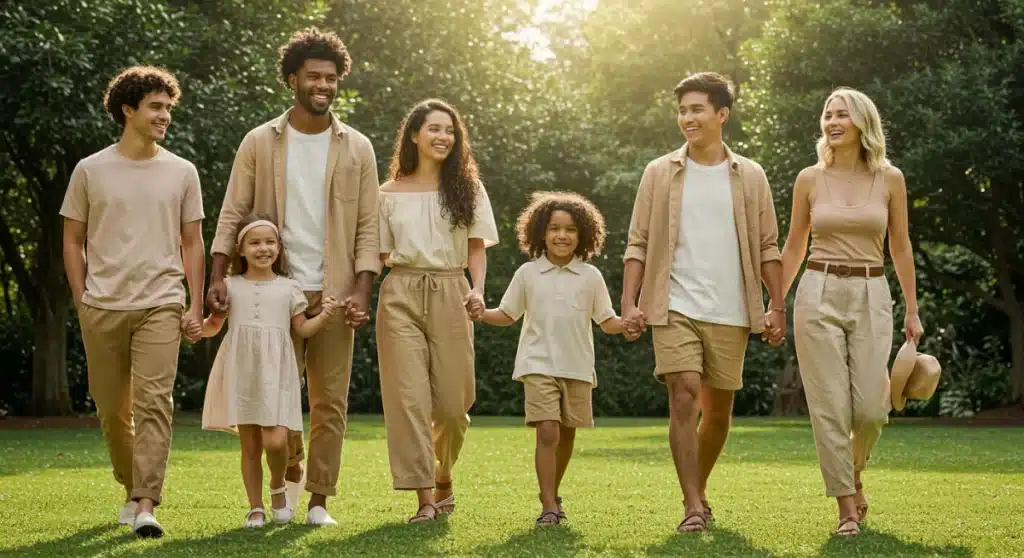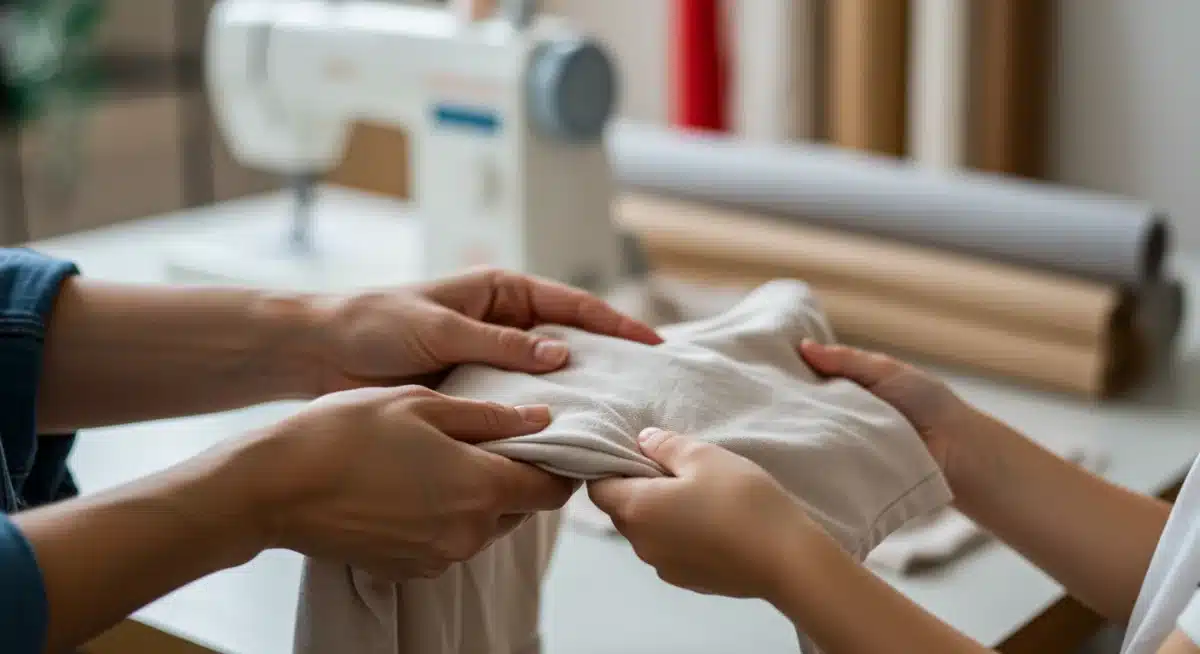Ethical Fashion Brands 2025: Making a Difference

Advertisement
Ethical fashion brands 2025 are leading the charge in sustainable and responsible apparel, offering consumers compelling choices that align with environmental values and social justice across the entire supply chain.
As we step further into 2025, the conversation around conscious consumption has never been more vital, especially concerning our wardrobes. The emergence of ethical fashion brands 2025 signifies a pivotal shift in how clothing is produced, consumed, and perceived, moving away from fast fashion’s detrimental impacts towards a more sustainable and equitable future for families everywhere.
Advertisement
Understanding ethical fashion: More than just a trend
Ethical fashion transcends mere trends; it represents a fundamental commitment to social and environmental responsibility throughout the entire clothing supply chain. This encompasses everything from the sourcing of raw materials to the manufacturing processes, labor conditions, and the product’s end-of-life.
For families, embracing ethical fashion means making choices that positively impact the planet and its people, ensuring that the clothes we wear and dress our children in are not contributing to exploitation or environmental degradation. It’s about aligning our purchasing power with our values, fostering a healthier future.
The pillars of ethical fashion
True ethical fashion stands on several key principles:
Advertisement
- Fair labor practices: Ensuring safe working conditions, fair wages, and reasonable hours for all garment workers. This combats issues like child labor and sweatshops, prevalent in conventional fashion.
- Environmental sustainability: Minimizing ecological footprint by using organic, recycled, or upcycled materials, reducing water and energy consumption, and avoiding harmful chemicals.
- Animal welfare: Opting for cruelty-free materials and production methods, avoiding animal testing and harmful animal products.
- Transparency and traceability: Brands openly sharing information about their supply chains, allowing consumers to verify their ethical claims.
These pillars collectively define what it means for a brand to be truly ethical, moving beyond greenwashing to enact real, measurable change. As consumers, understanding these foundations empowers us to make more informed decisions.
The growing demand for ethical choices
The rise of ethical fashion is not accidental; it’s a direct response to growing consumer awareness and demand. More families are seeking out brands that align with their values, prioritizing quality, durability, and a positive impact over fleeting trends. This shift is particularly noticeable in segments catering to children and teenagers, where parents are increasingly concerned about the provenance and safety of materials.
The market is responding, with an increasing number of innovative brands offering stylish and sustainable alternatives. This growing demand creates a positive feedback loop, encouraging more companies to adopt ethical practices and making sustainable choices more accessible than ever before.
In conclusion, ethical fashion is a holistic approach to clothing production and consumption that prioritizes people and the planet. By understanding its core principles and the forces driving its growth, families can confidently navigate the market and support brands that genuinely make a difference. It’s a movement towards a more conscious and responsible way of dressing, reflecting a deeper commitment to our shared future.
Why 2025 is a landmark year for sustainable style
2025 marks a crucial turning point for sustainable style, driven by a confluence of technological advancements, heightened consumer awareness, and evolving regulatory landscapes. This year, we are witnessing an unprecedented acceleration in the adoption of ethical practices, moving from niche interest to mainstream imperative.
The fashion industry, long criticized for its environmental and social impacts, is undergoing a significant transformation. Brands that once paid lip service to sustainability are now embedding it into their core business models, recognizing that ethical practices are not just good for the planet but also essential for long-term commercial viability.
Technological innovations driving change
Breakthroughs in material science and production technologies are revolutionizing ethical fashion. Innovations such as lab-grown leather, bio-based textiles derived from algae or mushrooms, and advanced recycling processes are making sustainable alternatives more viable and scalable than ever before. These technologies reduce reliance on traditional resource-intensive materials and minimize waste, offering exciting new possibilities for eco-conscious design.
- Bio-fabricated materials: New textiles created from biological processes offer sustainable alternatives to conventional fabrics, reducing environmental impact.
- Advanced recycling: Innovations in textile recycling are allowing for more efficient recovery and reuse of materials, closing the loop on fashion waste.
- 3D printing and on-demand production: These methods reduce overproduction and waste by allowing garments to be made only when needed, minimizing inventory and resource consumption.
These advancements are making it easier for brands to innovate without compromising on ethical standards, paving the way for a truly circular fashion economy.
Consumer empowerment and education
The internet and social media have empowered consumers like never before. Access to information about supply chains, brand practices, and environmental impacts is readily available, allowing individuals to make informed purchasing decisions. Educational initiatives by non-profits and conscious fashion advocates further amplify this awareness, fostering a generation of consumers who demand transparency and accountability.
This heightened consumer scrutiny compels brands to be more transparent and to genuinely commit to ethical practices. The collective power of consumers choosing ethical fashion brands 2025 is a significant catalyst for change, demonstrating that sustainability is not just a corporate responsibility but also a market driver.
Policy and regulatory shifts
Governments and international bodies are increasingly implementing policies aimed at regulating the fashion industry’s environmental and social impacts. These regulations, ranging from waste reduction targets to labor protection laws, create a more level playing field for ethical brands and pressure conventional brands to adopt more responsible practices. In 2025, we see a stronger push for compliance and accountability, making it harder for brands to ignore their ethical responsibilities.
In summary, 2025 represents a pivotal moment for sustainable style, propelled by innovation, informed consumers, and supportive policies. This convergence of factors is accelerating the shift towards a more ethical and environmentally friendly fashion industry, offering hope for a future where style and sustainability go hand in hand.
Spotlight on leading ethical fashion brands in 2025
The landscape of ethical fashion is vibrant and diverse, with numerous brands making significant strides in sustainability and social responsibility. In 2025, several brands stand out for their innovative approaches, transparent practices, and commitment to making a positive impact. These brands offer a wide range of products, from everyday wear to specialized items, proving that ethical choices don’t mean compromising on style or quality.
For families looking to build a conscious wardrobe, knowing which brands are truly leading the charge is essential. This section highlights some of the trailblazers in the ethical fashion movement, showcasing their unique contributions and how they embody the principles of responsible manufacturing and consumption.
Pioneering brands and their unique contributions
Many brands are pushing the boundaries of what’s possible in ethical fashion. For instance, some focus on circularity, designing garments that can be fully recycled or composted at the end of their life. Others specialize in using innovative, eco-friendly materials like organic hemp, recycled PET, or Tencel, significantly reducing their environmental footprint. Still more are dedicated to empowering artisans and promoting fair trade practices in developing countries, ensuring workers receive living wages and safe conditions.

Examples of impact-driven brands
Consider brands that:
- Prioritize regenerative agriculture: Sourcing cotton and other natural fibers from farms that actively improve soil health and biodiversity.
- Implement closed-loop systems: Designing clothing to be reused, repaired, or recycled, minimizing waste and maximizing resource efficiency.
- Invest in local communities: Supporting local economies by producing goods domestically and providing fair employment opportunities.
- Champion fair trade certifications: Ensuring that every step of their supply chain adheres to strict ethical and labor standards, verified by independent third parties.
These examples illustrate the diverse ways ethical brands are making a tangible difference. They are not just selling clothes; they are selling a vision for a better future, one stitch at a time.
How to identify truly ethical brands
With the rise of greenwashing, it’s crucial for consumers to be able to distinguish genuinely ethical brands from those merely claiming to be. Look for:
- Certifications: GOTS (Global Organic Textile Standard), Fair Trade, B Corp, and Oeko-Tex are strong indicators of ethical practices.
- Transparency: Brands that openly share their supply chain information, including factory locations and worker conditions, demonstrate a commitment to accountability.
- Material choices: A preference for sustainable materials like organic cotton, recycled polyester, linen, hemp, and Tencel.
- Longevity and quality: Ethical brands often focus on creating durable, timeless pieces designed to last, countering the fast fashion cycle.
By focusing on these indicators, families can confidently support ethical fashion brands 2025 that are truly dedicated to making a positive impact. This informed approach helps foster a more responsible consumer culture and rewards brands committed to genuine change.
The impact of ethical fashion on families and children
The choices we make in fashion extend far beyond personal style; they have profound implications for our families, our children, and the world they will inherit. Embracing ethical fashion offers numerous benefits, from ensuring safer products for young ones to instilling values of sustainability and social responsibility in the next generation.
For parents, the decision to opt for ethical clothing is often driven by a desire to protect their children’s health, support fair labor, and contribute to a healthier planet. It’s about making conscious choices that reflect a deeper commitment to family well-being and global citizenship.
Safer clothing for children
One of the most immediate benefits of ethical fashion for families is the assurance of safer products. Many conventional clothing items, especially those made for children, can contain harmful chemicals from dyes, finishes, and synthetic materials. Ethical brands, however, often prioritize:
- Organic and natural fibers: Reducing exposure to pesticides and chemical fertilizers used in conventional cotton farming.
- Non-toxic dyes: Using natural or low-impact dyes that are free from heavy metals and other harmful substances.
- Hypoallergenic materials: Choosing materials known for their gentleness on sensitive skin, reducing the risk of allergies and irritations.
This focus on purity ensures that children’s clothing is not only comfortable but also free from potentially harmful substances, providing peace of mind for parents.
Teaching conscious consumerism to the next generation
Beyond the tangible benefits, ethical fashion serves as a powerful educational tool. By choosing ethical brands, parents can teach their children about the importance of:
- Environmental stewardship: Understanding how clothing choices impact ecosystems and natural resources.
- Social justice: Learning about fair labor practices and the dignity of work, fostering empathy and global awareness.
- Longevity over disposability: Appreciating the value of well-made items that last, rather than succumbing to the fast fashion cycle.
These lessons cultivate a generation of conscious consumers who are equipped to make informed decisions and advocate for a more just and sustainable world. It transforms shopping from a mere transaction into an act of ethical engagement.
Building a sustainable family wardrobe
Creating an ethical family wardrobe involves more than just buying new clothes; it’s about adopting a holistic approach to consumption. This includes:
- Investing in quality over quantity: Choosing durable, well-made pieces that can withstand the rigors of childhood and be passed down.
- Repairing and upcycling: Extending the life of garments through mending, altering, or transforming them into new items.
- Donating and reselling: Giving clothes a second life through charitable donations or consignment, reducing textile waste.
By embracing these practices, families can minimize their environmental impact, save money in the long run, and foster a more sustainable lifestyle. The shift towards ethical fashion is a journey that benefits not only the planet but also the health and values of our families.
Navigating certifications and labels in ethical fashion
The world of ethical fashion can sometimes feel overwhelming, with a myriad of certifications, labels, and claims. Understanding these marks is crucial for consumers who want to confidently support genuinely ethical brands and avoid greenwashing. These certifications provide independent verification that a brand meets specific environmental, social, or labor standards.
For families, knowing what to look for on a clothing label can make all the difference in making truly informed decisions. It allows us to cut through the marketing noise and identify brands that are truly committed to responsible practices.
Key certifications to look for
Several certifications stand out as reliable indicators of ethical practices:
- Global Organic Textile Standard (GOTS): This is the world’s leading processing standard for textiles made from organic fibers. It ensures environmental and social criteria are met throughout the entire textile supply chain.
- Fair Trade Certified: This label guarantees that products were made according to rigorous fair trade standards, promoting sustainable livelihoods and safe working conditions for farmers and workers.
- B Corp Certification: B Corps are companies that meet the highest standards of verified social and environmental performance, public transparency, and legal accountability.
- Oeko-Tex Standard 100: This certification ensures textiles are tested for harmful substances and are safe for human health, particularly important for baby and children’s clothing.
- Bluesign: A system that provides solutions for sustainable textile production, eliminating harmful substances from the beginning of the manufacturing process.
These labels act as trusted guides, helping consumers identify products that align with their ethical values. They streamline the process of choosing responsible fashion, making it easier for busy families.
Understanding different label claims
Beyond formal certifications, brands often use various terms to describe their ethical practices. It’s important to understand what these terms truly mean:
- “Sustainable”: A broad term that can refer to various environmental and social aspects. Look for specific details to back up this claim.
- “Eco-friendly”: Often implies minimal harm to the environment. Again, transparency about materials and processes is key.
- “Organic”: Generally refers to materials grown without synthetic pesticides or fertilizers. GOTS certification provides stronger assurance.
- “Recycled”: Indicates materials made from post-consumer or post-industrial waste. Verify the percentage of recycled content.
Consumers should be wary of vague claims and always seek out specific evidence or third-party certifications. A truly ethical brand will be transparent about its practices and proud to share its journey towards sustainability.
The role of transparency in brand credibility
Transparency is the cornerstone of trust in ethical fashion. Brands that openly share details about their supply chain, from fiber sourcing to factory conditions, demonstrate a genuine commitment to accountability. This includes providing information on:
- Factory locations and audits: Allowing consumers to see where their clothes are made and under what conditions.
- Worker wages and benefits: Demonstrating fair compensation and treatment for all employees.
- Environmental impact reports: Quantifying efforts to reduce water usage, carbon emissions, and waste.
In conclusion, navigating certifications and labels requires a discerning eye, but it’s a vital step in supporting genuinely ethical fashion brands 2025. By prioritizing certified and transparent brands, families can ensure their purchasing power contributes to a more responsible and sustainable industry, making a real difference with every choice.
Practical steps to support ethical fashion brands in 2025
Supporting ethical fashion brands in 2025 is more accessible than ever, and every conscious choice contributes to a larger movement towards a more sustainable and equitable industry. Families can play a significant role by adopting practical habits that align with ethical consumption, fostering a wardrobe that reflects their values without compromising on style or functionality.
Transitioning to an ethical wardrobe doesn’t require an overnight overhaul; it’s a gradual process of making informed decisions and embracing new shopping habits. Here are some actionable steps to help your family support the ethical fashion movement.
Making informed purchasing decisions
The first step is to educate yourself and your family about the brands you choose. Before making a purchase:
- Research brands: Look into their ethical policies, material sourcing, and labor practices. Websites like Good On You offer ratings and reviews for thousands of brands.
- Read labels carefully: Check for certifications (GOTS, Fair Trade, Oeko-Tex) and material compositions. Prioritize natural, organic, or recycled fibers.
- Ask questions: Don’t hesitate to contact brands directly if you have doubts about their ethical claims. Transparency is a hallmark of truly responsible companies.
By taking the time to research, you ensure that your money supports companies that genuinely align with your values, making a positive impact with every purchase.
Embracing the “buy less, choose well, make it last” philosophy
One of the most powerful ways to support ethical fashion is to shift away from the fast fashion mindset. This means:
- Prioritizing quality over quantity: Invest in durable, well-made pieces that will last longer, reducing the need for frequent replacements.
- Choosing timeless styles: Opt for classic designs that won’t go out of fashion quickly, maximizing the wearability of each item.
- Caring for your clothes: Proper washing, drying, and storage can significantly extend the life of your garments, reducing textile waste.
This approach not only benefits the environment but also often saves money in the long run, as fewer, higher-quality items replace a constant stream of disposable fashion. It encourages a more mindful relationship with our possessions.
Exploring second-hand and rental options
Supporting ethical fashion isn’t just about buying new ethical items. The circular economy offers fantastic alternatives:
- Thrift stores and consignment shops: A treasure trove for unique, affordable, and pre-loved fashion items for the whole family.
- Online marketplaces: Platforms for buying and selling second-hand clothing, giving garments a new life.
- Clothing rental services: Ideal for special occasions or trying out new styles without a long-term commitment, especially for children’s rapidly growing wardrobes.
These options reduce demand for new production, divert textiles from landfills, and make fashion more accessible and sustainable. They are perfect for budget-conscious families looking to make ethical choices.
In conclusion, supporting ethical fashion brands 2025 involves a combination of informed purchasing, mindful consumption, and embracing circular economy models. By integrating these practical steps into our daily lives, families can collectively drive significant change, contributing to a fashion industry that is both stylish and responsible.
The future of ethical fashion: Trends beyond 2025
As we look beyond 2025, the trajectory of ethical fashion points towards even greater innovation, integration, and impact. The foundations laid by current ethical fashion brands are paving the way for a future where sustainability and responsibility are not just options but fundamental expectations across the entire industry. This evolution will touch every aspect of clothing, from design to disposal, creating a truly transformative landscape.

For families, this means an increasing array of choices that align with their values, making it easier to dress consciously while enjoying cutting-edge style and comfort. The future promises a fashion world that is not only beautiful but also inherently good.
Hyper-localization and micro-manufacturing
One significant trend expected to gain momentum is the shift towards hyper-localization. This involves:
- Local production: Reducing carbon footprint by manufacturing closer to consumers, minimizing transportation.
- Artisan empowerment: Supporting local craftsmanship and traditional skills, fostering unique, high-quality products.
- Community engagement: Building stronger connections between consumers and producers, enhancing transparency and trust.
Micro-manufacturing, facilitated by advanced technologies like 3D printing, will allow for on-demand production, further reducing waste and enabling highly personalized fashion. This localized approach fosters resilience and supports local economies, creating a more distributed and ethical fashion system.
Digital innovation and transparency
Technology will continue to play a pivotal role in enhancing transparency and traceability:
- Blockchain for supply chains: Providing immutable records of a garment’s journey, from raw material to retail, ensuring authenticity and ethical claims.
- AI-driven sustainability analytics: Helping brands optimize production processes, minimize waste, and track their environmental impact more accurately.
- Virtual try-on and digital fashion: Reducing the need for physical samples and returns, thereby lowering environmental costs associated with logistics and overproduction.
These digital innovations will make it easier for consumers to access detailed information about their clothing, empowering them to make even more informed ethical choices. The future of ethical fashion is deeply intertwined with technological progress.
Regenerative fashion and circularity at scale
The concept of regenerative fashion, which aims to restore and rejuvenate ecosystems rather than just minimize harm, will become more prevalent. This includes:
- Biodegradable and compostable materials: Designing garments that can safely return to the earth at the end of their life cycle.
- Zero-waste design: Techniques that eliminate fabric waste during the cutting and sewing process.
- Repair and resale ecosystems: Robust infrastructure supporting the repair, resale, and recycling of garments, ensuring materials remain in use.
The vision is a truly circular economy where fashion items are designed for longevity, easy repair, and ultimate regeneration, leaving no negative impact. This holistic approach ensures that fashion actively contributes to a healthier planet.
In summary, the future of ethical fashion beyond 2025 is bright, characterized by hyper-localization, digital transparency, and a widespread commitment to regenerative practices. These trends promise a fashion industry that is not only sustainable but actively beneficial for both people and the planet, offering families a truly conscious and beautiful way to dress.
| Key Aspect | Brief Description |
|---|---|
| Ethical Foundations | Focuses on fair labor, environmental sustainability, animal welfare, and supply chain transparency. |
| 2025 Drivers | Technological innovation, consumer awareness, and regulatory shifts are accelerating ethical practices. |
| Family Impact | Ensures safer products for children and teaches conscious consumption values to the next generation. |
| Supporting Brands | Research certifications, embrace quality over quantity, and explore second-hand or rental options. |
Frequently asked questions about ethical fashion in 2025
An ethical fashion brand in 2025 prioritizes fair labor practices, environmental sustainability, animal welfare, and full transparency across its supply chain. They often use eco-friendly materials, minimize waste, and ensure safe, equitable working conditions for all involved in production.
Look for third-party certifications like GOTS, Fair Trade, B Corp, or Oeko-Tex. Genuinely ethical brands are transparent about their supply chains, factory locations, and material sourcing. Be wary of vague claims without specific supporting evidence or certifications.
Ethical fashion ensures safer clothing for children by using non-toxic, organic materials. It also teaches conscious consumerism, environmental stewardship, and social justice values to the next generation, fostering a more responsible approach to consumption.
While some ethical items may have a higher initial cost, they often offer better quality and longevity, leading to savings over time. Exploring second-hand stores, clothing swaps, and rental services also provides affordable and sustainable options for families on a budget.
Beyond 2025, expect growth in hyper-localization, micro-manufacturing, and advanced digital transparency through blockchain and AI. Regenerative fashion practices and widespread circularity, including biodegradable materials and robust repair ecosystems, will also become more prevalent.
Conclusion
The emergence and growth of ethical fashion brands 2025 represent a significant and hopeful shift within the industry, offering families across the United States the power to make fashion choices that truly align with their values. By embracing transparency, sustainability, and fair labor practices, these pioneering brands are not just selling clothes; they are building a foundation for a more responsible and equitable future. Supporting them, whether through informed purchases, embracing circularity, or simply spreading awareness, contributes to a collective movement that benefits our planet, its people, and the generations to come. The journey towards a fully ethical wardrobe is an ongoing one, but with each conscious decision, we move closer to a fashion landscape that is as beautiful as it is responsible.





